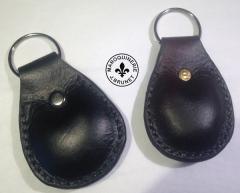-
Posts
243 -
Joined
-
Last visited
Content Type
Profiles
Forums
Events
Blogs
Gallery
Everything posted by TonyRV2
-

Bartender's Friend/ Oxalic Acid mix ratio?
TonyRV2 replied to CaptQuirk's topic in How Do I Do That?
About 1 tablespoon of BKF to a pint of water seems to be the usual mix. ...Tony -
Normally I just build my own work benches, but a few months ago decided to buy this workbench from Sam's Club: http://www.samsclub.com/sams/ultra-heavy-duty-workbench/prod1490086.ip Its very well made from square tubular steel and rated for 1000 pounds. I'm happy with the purchase although it is a bit smallish compared to my other benches... 25" X 72" but its perfect for what I wanted to do with it which was mostly stamping and drawing. Price was $200 ...Tony
-

Keychain Sap (Lead Filled)
TonyRV2 commented on Bonecross's gallery image in Our Leatherwork Galleries
-
wow...20 bucks for a keyring? I may start making them myself!!
-
How much could one of these things cost? Buy one, take it apart, instant pattern. Just saying.
-
First thing I would try would be to dampen it, lay it out straight and put some weight on it. Give it a day and see what happens.
-
My stomach sticks out further than my dinky doo.
-
This is a cruel joke to those of us that have dinky doo syndrome.
-
Without knowing much about the box that you've made here's another idea. Is the box going to be lined? You could incorporate the divider into the liner by building sort of a figure 8....but square. This would provide the divider and the lining for the sides. A separate piece would be cut to line the bottom.
-
I'm sorry that I don't have any pictures because I've never done this, but I do have an idea. Make a strap of two pieces of leather, glue and sew them back to back. Dont glue or sew the last two inches or there abouts on each end. You'll be able to fold open the ends of your strap to lie up against the inner wall of the box. Glue and then sew in place on each end. ....Tony
-
NV....you are at a whole 'nother place than the poster is. For someone that's established the sky's the limit and the market decides whether you're worth it or not. For someone starting out.....not so much.
-
Don't get me wrong. I agree that hand sewing is superior to machine sewn leather goods. The only point that I was making is that overhead costs (like purchasing and owning a sewing machine) may influence the price you charge for leather goods. Of course in some respect machine purchases are offset by savings in labor, but I would still advocate that labor is cheap. There is nothing in your shop that you pay less for than your own labor. I think this is where most of the leeway is in terms of setting a price for something.
-
Perhaps I should have pointed out that when I gave stuff away at cost it was to family members and close buddies....guys I thought I could count on to not give any more of my stuff away.
-
I think it depends upon how established you are as a leather work as well as your overhead, machinery, etc. If you don't have any machine costs and are hand sewing then imho I've always figured labor is cheap. Someone just starting out, unestablished with low overhead (and by that I mean without a solid customer base) might charge twice the cost of materials. For someone that has an established customer base with a lot of overhead (machine costs, building rent, etc.,) might get upwards of 40 or 50 dollars per hour on top of materials cost. So I guess the question you have to ask yourself is where you are given those two extremes and decide accordingly. Heck, starting out I would give stuff away at cost just to get word of mouth going.
-
I've done this on a limited basis with the belt loops on knife sheaths. Smoothing out the flesh side is just like burnishing the edges. I use watered down saddlesoap for this, but any liquid will do. Some prefer trag as mentioned above. All the liquid does is cuts down on heat so that you don't burn the leather when burnishing, which is especially important if you're using a power tool to do it as I do. I use a foredom flexshaft rotory tool with a wooden dowel attached for burnishing. I then go over that with a bone tool. Works out well for my purposes, although I would think that on a belt you're looking at a lot more work overall. Might be best as others have suggested to just line the belt with some thinner veg tan....2-1/2 or 3 ounce ought to do it.
-
I'd see no problem in doing this. You may want to rough up the surface of the plastic a bit to give it more adhesion. I would think that 100 or 220 grit sandpaper would do the job.
-
I'm afraid I have to agree with Ferg here, your methods lack discipline and it looks like you rushed through it, even though you likely spent hours on this. You need to take a step back and learn some basics before you get to the level that you want to be at. Al Stohlman's books have helped me tremendously in that regard. Start out with the book entitled "Figure Carving". You can find it on Ebay I'm sure. One thing that I always keep in mind as a result of having studied his books is to always cut and tool the foreground first and then work backwards into the picture. Do not even cut the background until you've finished the foreground. The background should be struck more delicately to give the illusion of depth. Things that are farther away do not appear to have as crisp an outline. The border should be tooled last. Your work on this project exhibits none of this....it all looks like its on one level because you cut and tooled it all at the same time. This also led to mistakes where you overlapped tooling from one part of the picture to another. Its great that your designing your own figures, but you should concentrate for a while on doing some work thats already been done so that you can see step by step how your goals may be accomplished. On another note, as you're learning, only follow one master because there are a variety of ways that you might accomplish the same result. Following just one master initially will clear a lot of the static from the airwaves. You can't hardly go wrong starting out with the Stohlman books.
-
Nice work Efrain. Welcome to the forum. Besides doing leather and making knives, I'm also an ameteur photographer. I've been kicking around the idea of making a camera bag but there's no urgency for me because I really like the store bought one that I'm currently using although it is made primarily from canvas and not leather. One day though. I'd also like to complement you on your command of the English language which I'm assuming is a second language for you. I have students in my college classroom that don't write as fluently as you do, sadly I might add. Closest I've been to Monterrey was Nuevo Laredo when my brother and I did a border run when he lived in San Antonio many years ago. A typical border town I know, and not representative of what Mexico is really like, which is why I've always wanted to visit a much less touristy place next time I'm down that way. One bit of advice about this forum...the built in search function leaves something to be desired, and that something is pertinent results, lol. Best to use google, or the search engine of your choice, to search a topic. Just include 'leatherworker' in the topic query. Knowing that, you should be able to find the answers to most of the questions that you'll have regarding leatherwork. ...Tony
- 11 replies
-
- introduction
- newbie
-
(and 2 more)
Tagged with:
-

Scrap Leather Smart Phone Case
TonyRV2 replied to ozhank's topic in Purses, Wallets, Belts and Miscellaneous Pocket Items
I'm guessing that you didn't clean the leather with some solvent, like denatured alcohol, prior to dying. This may have allowed the leather to take the dye more evenly. -

Can i spot dye my damaged goat leather wallet?
TonyRV2 replied to Stefan's topic in How Do I Do That?
You'll likely never match it perfectly, but what do you have to lose? I say dye it and at the very least the spot will be less noticeable. Take note of how the dye affects the immediate area around the spot. You might make a judgement call at that point to redye the entire piece in a darker shade. -
Looks like a good deal...I just don't know enough skinny people to take advantage of it.
-

Dark edge
TonyRV2 replied to Mattsbagger's topic in Dyes, Antiques, Stains, Glues, Waxes, Finishes and Conditioners.
My guess would be that the dye has leeched in from the unprotected edges of the hide. You may be able to minimize this by not letting the hide sit in the dye as long. Mind you, this is just a guess on my part as I've never personally dip dyed a piece of leather. The dark blotch near the bottom of the lower picture is tougher to explain I think. Thinner grain in that area? Residue on the rest of the hide that acted as a weak resist? Was the hide thoroughly cleaned with a solvent prior to dying? -

turning a barber chair into a draw-down pointers please
TonyRV2 replied to MarkB's topic in Saddle Trade Resources
Have pity on my feeble mind....what's a 'draw-down'? -
I had a different fix...I don't bevel until after I do the stitch groove.



